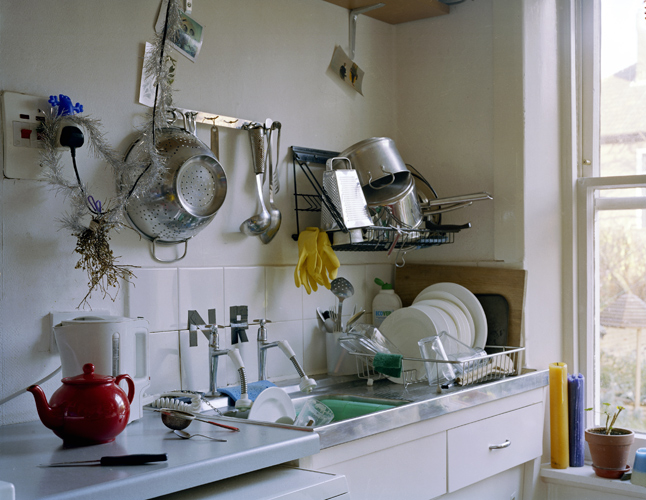Nigel Shafran – Washing Up
Nigel Shafans series ‘Washing Up’ is a collection of images alongside text which shows us the mundane daily chore of washing up along side a list of food and meals. I find it interesting to explore the image and attempt to decipher the time and month in which it was taken. I look for clues and I am left wondering who it was that washed up, where have they gone and what do they do?
http://nigelshafran.com/category/washing-up-2000-2000/page/2/ (Accessed 21.01.18)

Nigel Shafran, 4th January 2000. Three bean soup, cauliflower vegetable cheese. Morning
coffee and croissants. From the series Washing-up.
In this image I can see the remnants of Christmas as tinsel hangs by the colander but there are new buds showing on the plant by the window which has bathed the kitchen in a fresh white light. A teapot makes me wonder if there were guests for tea? The colours and shapes in this image work well together. The bright red round teapot, the tall cylindrical yellow and purple candles, the yellow marigold gloves and the green of the washing up bowl. The colours are bright yet seem subtle in the composition due to the fresh white light but they help to make your eyes travel around the image. The caption to the image which was provided in the course material is at odds with the image? I see teapot yet it says coffee, this makes me wonder further about who came to tea?
This style of Self Portraiture appeals to me, I am already thinking / leaning in this direction.
Did it surprise you that this was taken by a man? Why?
No, it didn’t surprise me? If the expected response would be because of gender roles then this is not something that would have occurred to me. My husband is equally capable of washing up or doing the laundry as I am so I do not see why a man taking a picture of a sink should surprise me. We only allude to the fact that he is the washer-up-er, he could merely be an observer?
In your opinion does gender contribute to the creation of an image?
Not necessarily but our creation of images comes from the influences of the world around us and what we are exposed to or experience. This then could contribute to the creation of an image in terms of gender.
What does this series achieve by not including people?
I am left to consider the scene and to draw conclusions or observations about both the photographer and his life. I am then left to think about what my own sink or meals would say about me and what this scenario is like around the world?
Do you regard them as interesting ‘ still life’ compositions?
An interesting composition is one which leaves me with questions and makes me consider things. I am drawn to these ‘still life’s’ and I find them to be an effective way to look at someone / someones life in a way in which you can draw parallels or sympathise. The mundane exists in everyone’s lives but this ‘still life’ highlights how individual yet shared the mundane can be.